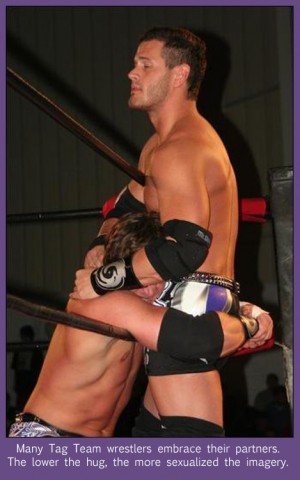 As defined last week, the term “homosocial” describes non-sexual relationships among people of the same gender. I believe pro wrestling is popular among men because it portrays numerous passionate, powerful homosocial relationships (which men crave) while staying on the safe side of the homosexual border by defining the physical contact as violence instead of intimacy.
As defined last week, the term “homosocial” describes non-sexual relationships among people of the same gender. I believe pro wrestling is popular among men because it portrays numerous passionate, powerful homosocial relationships (which men crave) while staying on the safe side of the homosexual border by defining the physical contact as violence instead of intimacy.
Some feminist scholars believe that all male relationships exist on a continuum somewhere in between homosocial (non sexual) and homosexual (gay). Men must carefully navigate this gray area, eager to bond as intimately as possible with other men and reap the benefits of male partnerships, while avoiding the social pitfalls of being pegged a Homo, Queer, or Sissy.
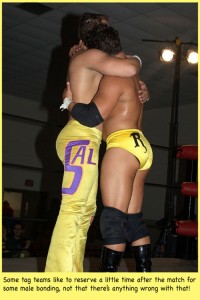 The term “male homosocial desire” was coined by feminists to describe this craving all men feel to be with other men, the need to be One of the Guys, to bond with other dudes. Feminists have noted that men maintain their power by sticking together, by enjoying the company of other men (to the exclusion of women) and benefiting from the resulting good will and partnerships.
The term “male homosocial desire” was coined by feminists to describe this craving all men feel to be with other men, the need to be One of the Guys, to bond with other dudes. Feminists have noted that men maintain their power by sticking together, by enjoying the company of other men (to the exclusion of women) and benefiting from the resulting good will and partnerships.
In pro wrestling, healthy and powerful male homosocial desire is portrayed by the Tag Teams and demonstrated during Tag Team matches. The men must partner up to enter the Tag Team competition. They must learn to trust each other, must think alike, we’re told, before they can succeed. These ambiguous “Tag Team bromances” are portrayed as being more intimate than the typical professional partnership between men, almost bordering on marriages.
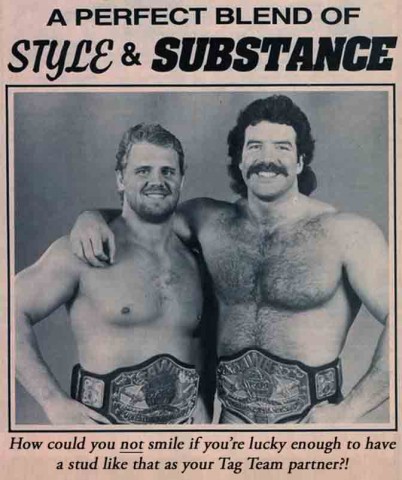 Consistent with the theories of feminist scholars, Tag Team wrestlers in fact gain their success, status, and wealth from their homosocial pairings. If the bond between the two men is strong enough, the commentators remind us, then the team will win the belts.
Consistent with the theories of feminist scholars, Tag Team wrestlers in fact gain their success, status, and wealth from their homosocial pairings. If the bond between the two men is strong enough, the commentators remind us, then the team will win the belts.
If they learn to think and act as one, they will defeat the competition.
If the fans buy into their relationship as a team, they’ll be popular and in demand. thereby earning more money.
![]()
Many Tag Teams act out scenes of male homosocial (or possibly homosexual) desire by blurring the line between an innocent friendship and the intimacy of a loving relationship.
They will often hug to celebrate a victory. While being interviewed, one partner may drape an arm across his partner’s shoulders. If one man is hurt, the other will cradle him to comfort and reassure him. If one man is in pain, the other will react with outrage and fury, anxious over his partner’s misfortune. The implication is that the watcher feels compassion for his suffering partner: his pain is my pain because I have strong feelings for him.
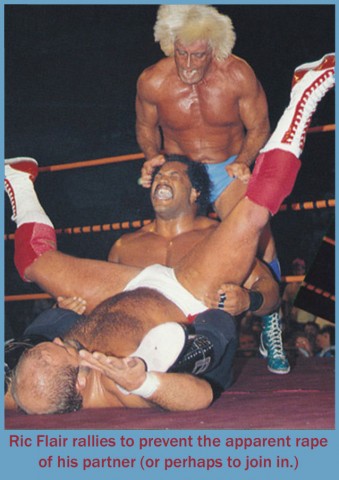 If the partner in the ring is being abused or molested, his devoted partner will rush to his rescue, like Prince Charming rushing to the aid of a Damsel in Distress. The rescuer makes the villain pay for his cruelty, a measure of retribution against the thug who has dared to harm his beloved and vulnerable partner.
If the partner in the ring is being abused or molested, his devoted partner will rush to his rescue, like Prince Charming rushing to the aid of a Damsel in Distress. The rescuer makes the villain pay for his cruelty, a measure of retribution against the thug who has dared to harm his beloved and vulnerable partner.
A “Real Man” is supposed to be a lone wolf, fighting his own battles and succeeding by his strength alone. But Tag Team wrestling undermines the masculine ideal, forever re-asserting the importance of homosocial relations to achieve success. The injured wrestler in the ring is forced to admit that he needs another man to come to his rescue — that he needs to tag out and be saved by someone stronger.
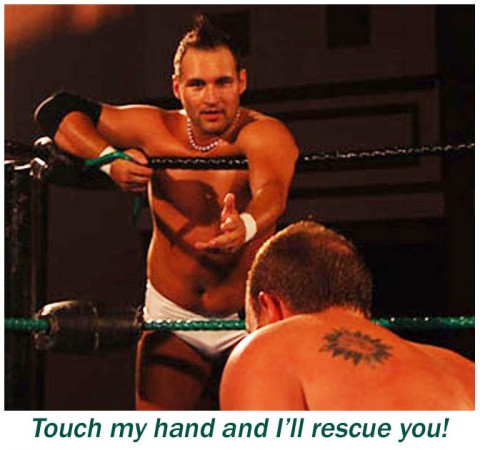 Another common depiction of homosocial desire occurs when the partner in the ring struggles to make the tag. He is seen reaching desperately, eagerly, for his partner’s hand. He crawls slowly toward his man, aching for rescue, striving to make contact. He needs (desires?) physical contact.
Another common depiction of homosocial desire occurs when the partner in the ring struggles to make the tag. He is seen reaching desperately, eagerly, for his partner’s hand. He crawls slowly toward his man, aching for rescue, striving to make contact. He needs (desires?) physical contact.
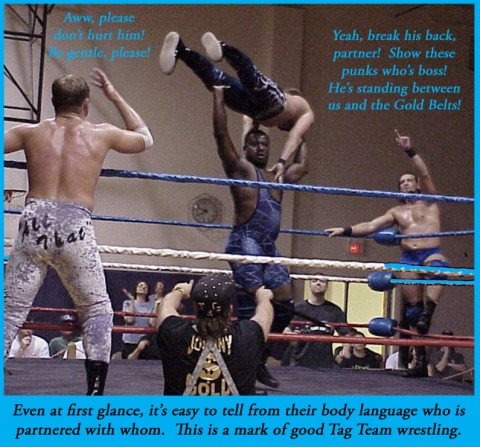 The wrestler suffering in the ring needs to be saved by his Tag Team partner, unable to achieve success unless he draws on his partner’s masculinity and power. This is the very basis of male homosocial desire — where power and strength are derived from the bond formed with other men.
The wrestler suffering in the ring needs to be saved by his Tag Team partner, unable to achieve success unless he draws on his partner’s masculinity and power. This is the very basis of male homosocial desire — where power and strength are derived from the bond formed with other men.
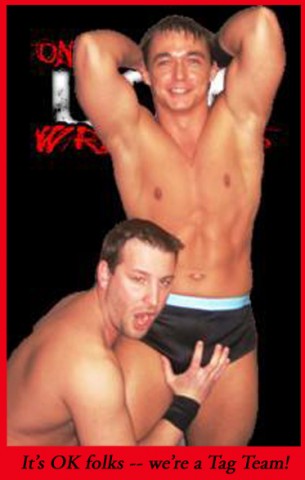 Some of the villainous Tag Teams, it is implied, have crossed the line into a dirty homosexual relationship. These bastards are seen as morally corrupt and disgusting already, so the straight male fans can easily increase their hatred for “those cheating faggots” while continuing to cheer for the good, straight Tag Teams (who are relatively less queer.)
Some of the villainous Tag Teams, it is implied, have crossed the line into a dirty homosexual relationship. These bastards are seen as morally corrupt and disgusting already, so the straight male fans can easily increase their hatred for “those cheating faggots” while continuing to cheer for the good, straight Tag Teams (who are relatively less queer.)
This is how pro wrestling cleverly enables the “healthy”, presumably non-sexual, but powerfully intimate homosocial relationships (which all men crave) between the hero wrestlers — by contrasting them with more overt, sissified, queer-as-can-be villain teams. The two good partners can safely kiss each other if they want to, because they’re the Good Guys and way less gay-acting than many of the Heel teams.

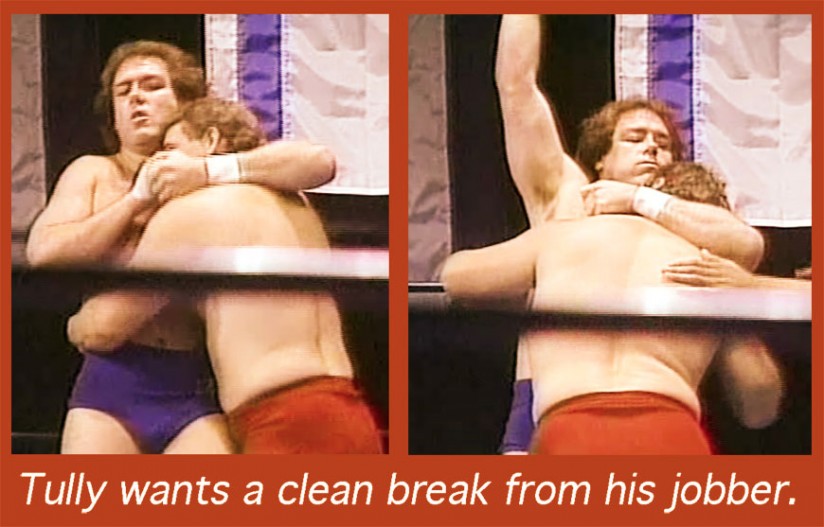
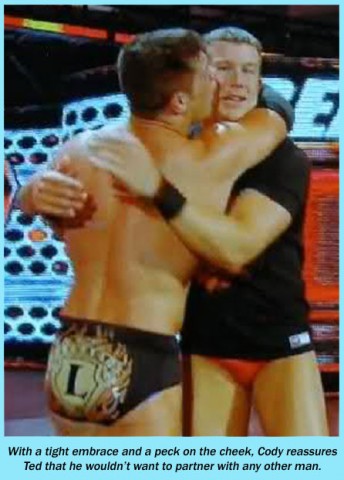
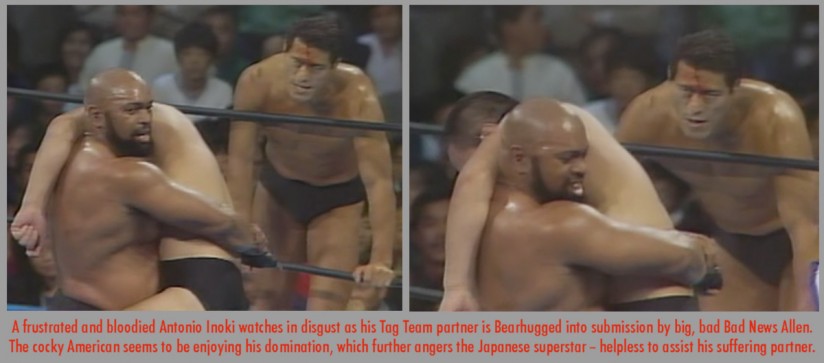
Who are the two guys in the last picture?